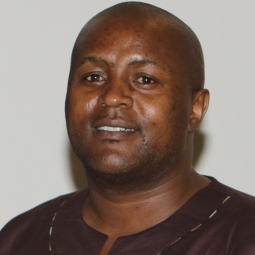The science of making machines 'see and think'
Fred Senekal is passionate about making robots 'see and think'. His research is about making them do just that by applying his expertise in computer vision to enhance their intelligence. Computer vision focuses on the theory and technology for building artificial systems that obtain information from images or multi-dimensional data. "When the opportunity presented itself for me to join the CSIR's research group working on mobile intelligent autonomous systems, I was very excited," he recalls.
Fred Senekal is passionate about making robots 'see and think'. His research is about making them do just that by applying his expertise in computer vision to enhance their intelligence. Computer vision focuses on the theory and technology for building artificial systems that obtain information from images or multi-dimensional data. "When the opportunity presented itself for me to join the CSIR's research group working on mobile intelligent autonomous systems, I was very excited," he recalls. "It was amazing to think that I would be doing research in field robotics - a new area of research in South Africa."
Senekal witnessed the dawn of mobile intelligent autonomous systems (MIAS) as a CSIR emerging research area in May 2007; as a CSIR senior researcher, he is now the longest serving researcher in this area.
Driverless vehicles
"The first year was challenging as it took us a while to get things going and sort out issues like acquiring robotic infrastructure, workstations and facilities," notes Senekal. "However, we got the ball rolling and started work on the CSIR Autonomous Rover (CAR) project."
Developing a vehicle capable of driving autonomously using GPS and local sensors was an opportunity for CSIR researchers to showcase their robotics capability and skills set to the organisation and the country. It was completed by a team of three researchers and ratified as a technology demonstrator in 2011. The CAR team members, Senekal, Deon Sabatta and Michael Burke, received organisational recognition for their work, and they accepted an award for 'Outstanding Contribution by a Team' at a unit Excellence Awards ceremony.
Senekal is now working on an autonomous mule. "The mule is a vehicle capable of following a person or vehicle autonomously," he says. "Imagine, for example, a convoy of vehicles following one another, with one driver only in the lead vehicle; an autonomous mule will follow the lead vehicle. An autonomous mule would be able to follow a person, carrying heavy equipment on behalf of that person," he adds.
"The mule has the ability to build a map of its environment en route to its destination. It also has the ability to explore parts of the environment on its own. This will enable it to go back to its original point of departure without human intervention," Senekal states.
Research building blocks
In some areas particularly, the MIAS group has developed good expertise and delivered reliable software and platforms. "We have a good sense of what problems are faced in robotics and the challenges involved in solving those problems," notes Senekal. Researchers focus on the intelligence problems related to robotics, thereby giving robots 'brains to think'. Computer vision expertise is particularly relevant in addressing such research challenges.
Senekal specialises in computer vision and has recently published papers on visual tracking, traffic sign recognition and road segmentation. "Computer vision is the process of turning the imagery into a description of the environment, which is useful to a robot," he explains. "The challenge is to interpret the data in the imagery in a way that enables the robot to execute its required actions reliably and to do this with sufficient speed to ensure real-time operation."
Lately, he has been working on planning algorithms. He has developed algorithms for global planning in uncertain terrains. This enables a robot to navigate along an optimal path between two points, even when the environment between the two points is partially unknown.
The future for robotics research
Senekal is confident about the future of robotics research at the CSIR, "We have become a South African robotics hub and continue to strengthen our capabilities. The scope of our research looks set to grow as the world demands more intelligence in robots than that available commercially."
He mentions intelligent systems such as adaptive cruise control, lane departure warning systems, autonomous parallel parking in cars and other technologies. "In future, we will see more autonomous vehicles on the roads, intelligent systems in households and more adaptation of intelligent systems embedded in our lives," he concludes.
Senekal is a CSIR senior researcher specialising in MIAS assigned to the modelling and digital science unit at the CSIR. He has a Master's degree in computer engineering from the University of Pretoria.

